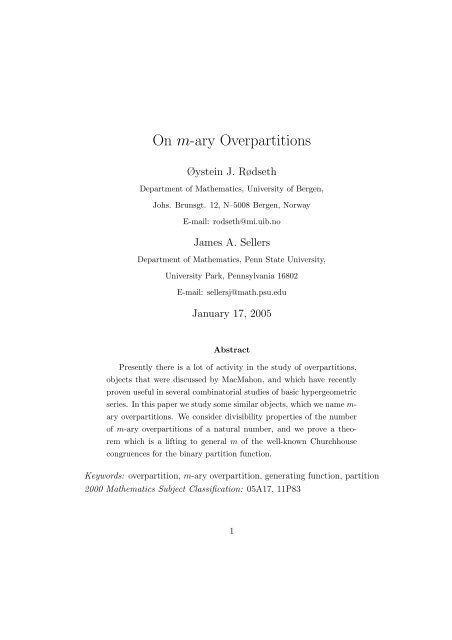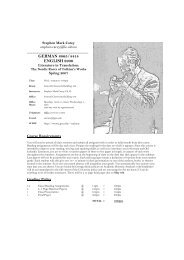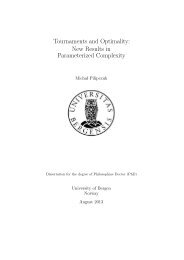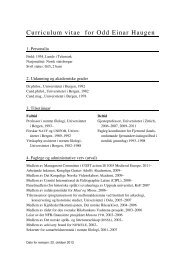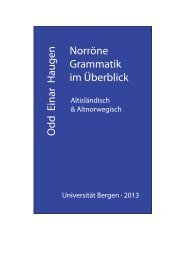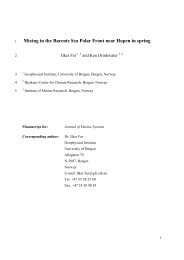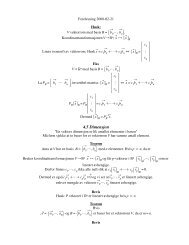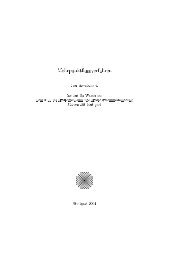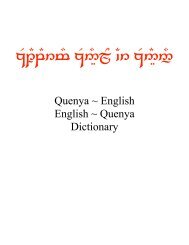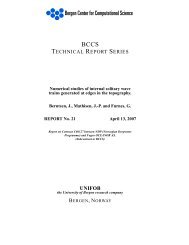On m-ary Overpartitions - Penn State Personal Web Server - Penn ...
On m-ary Overpartitions - Penn State Personal Web Server - Penn ...
On m-ary Overpartitions - Penn State Personal Web Server - Penn ...
Create successful ePaper yourself
Turn your PDF publications into a flip-book with our unique Google optimized e-Paper software.
<strong>On</strong> m-<strong>ary</strong> <strong>Overpartitions</strong><br />
Øystein J. Rødseth<br />
Department of Mathematics, University of Bergen,<br />
Johs. Brunsgt. 12, N–5008 Bergen, Norway<br />
E-mail: rodseth@mi.uib.no<br />
James A. Sellers<br />
Department of Mathematics, <strong>Penn</strong> <strong>State</strong> University,<br />
University Park, <strong>Penn</strong>sylvania 16802<br />
E-mail: sellersj@math.psu.edu<br />
Janu<strong>ary</strong> 17, 2005<br />
Abstract<br />
Presently there is a lot of activity in the study of overpartitions,<br />
objects that were discussed by MacMahon, and which have recently<br />
proven useful in several combinatorial studies of basic hypergeometric<br />
series. In this paper we study some similar objects, which we name m-<br />
<strong>ary</strong> overpartitions. We consider divisibility properties of the number<br />
of m-<strong>ary</strong> overpartitions of a natural number, and we prove a theo-<br />
rem which is a lifting to general m of the well-known Churchhouse<br />
congruences for the bin<strong>ary</strong> partition function.<br />
Keywords: overpartition, m-<strong>ary</strong> overpartition, generating function, partition<br />
2000 Mathematics Subject Classification: 05A17, 11P83<br />
1
1 Introduction<br />
Presently there is a lot of activity in the study of the objects named over-<br />
partitions by Corteel and Lovejoy [2]. According to Corteel and Lovejoy,<br />
these objects were discussed by MacMahon and have recently proven useful<br />
in several combinatorial studies of basic hypergeometric series. In this paper<br />
we study some similar objects, which we name m-<strong>ary</strong> overpartitions.<br />
Let m ≥ 2 be an integer. An m-<strong>ary</strong> partition of a natural number n is a<br />
non-increasing sequence of non-negative integral powers of m whose sum is<br />
n. An m-<strong>ary</strong> overpartition of n is a non-increasing sequence of non-negative<br />
integral powers of m whose sum is n, and where the first occurrence of a power<br />
of m may be overlined. We denote the number of m-<strong>ary</strong> overpartitions of n<br />
by bm(n). The overlined parts form an m-<strong>ary</strong> partition into distinct parts,<br />
and the non-overlined parts form an ordin<strong>ary</strong> m-<strong>ary</strong> partition. Thus, putting<br />
bm(0) = 1, we have the generating function<br />
Fm(q) =<br />
∞<br />
bm(n)q n =<br />
n=0<br />
For example, for m = 2, we find<br />
∞<br />
n=0<br />
∞<br />
i=0<br />
1 + q mi<br />
1 − q mi .<br />
b2(n)q n = 1 + 2q + 4q 2 + 6q 3 + 10q 4 + 14q 5 + . . . ,<br />
where the 10 bin<strong>ary</strong> overpartitions of 4 are<br />
1 + 1 + 1 + 1, 1 + 1 + 1 + 1, 2 + 1 + 1, 2 + 1 + 1,<br />
2 + 1 + 1, 2 + 1 + 1, 2 + 2, 2 + 2, 4, 4.<br />
The main object of this paper is to prove the following theorem.<br />
Theorem 1 For each integer r ≥ 1, we have<br />
bm(m r+1 n) − bm(m r−1 n) ≡ 0 (mod 4m ⌊3r/2⌋ /c ⌊(r−1)/2⌋ ),<br />
where c = gcd(3, m).<br />
2
(1)<br />
Putting m = 2 in Theorem 1, we get<br />
b2(2 r+1 n) − b2(2 r−1 n) ≡ 0 (mod 2 ⌊3r/2⌋+2 ) for r ≥ 1.<br />
Writing b2(n) for the number of bin<strong>ary</strong> partitions of n, we have, as noted in<br />
the next section, that b2(n) = b2(2n). Thus (1) can be written as<br />
(2)<br />
b2(2 r+2 n) − b2(2 r n) ≡ 0 (mod 2 ⌊3r/2⌋+2 ) for r ≥ 1.<br />
This result was conjectured by Churchhouse [1]. A number of proofs of (2)<br />
have been given by several authors; cf. [4]. Families of congruences also<br />
appear in the literature for the m-<strong>ary</strong> partition function which are valid for<br />
any m ≥ 2; cf. [3]. But as far as we know, none of these m-<strong>ary</strong> results<br />
give the Churchhouse congruences when m = 2. So, Theorem 1 seems to be<br />
the first known lifting to general m of the Churchhouse congruences for the<br />
bin<strong>ary</strong> partition function.<br />
We prove Theorem 1 by adapting the technique used in [3]. In Section<br />
2 below we introduce some tools and prove three lemmata. In Section 3 we<br />
complete the proof of Theorem 1. Finally, in Section 4 we state a theorem<br />
which generalizes Theorem 1 and sketch its proof.<br />
2 Auxiliaries<br />
Although many of the objects below depend on m or q (or both), such de-<br />
pendence will sometimes be suppressed by the chosen notation.<br />
The power series in this paper will be elements of Z[[q]], the ring of formal<br />
power series in q with coefficients in Z. We define a Z-linear operator<br />
by<br />
U : Z[[q]] −→ Z[[q]]<br />
U <br />
a(n)q n = <br />
a(mn)q n .<br />
n<br />
3<br />
n
Notice that if f(q), g(q) ∈ Z[[q]], then<br />
(3)<br />
U(f(q)g(q m )) = (Uf(q))g(q).<br />
Moreover, if f(q) = <br />
n a(n)qn ∈ Z[[q]], and M is a positive integer, then we<br />
have<br />
if and only if, for all n,<br />
f(q) ≡ 0 (mod M) (in Z[[q]])<br />
a(n) ≡ 0 (mod M) (in Z).<br />
At this point, a note is in order on the relationship between the bin<strong>ary</strong><br />
partition function b2(n) and the bin<strong>ary</strong> overpartition function b2(n). Since<br />
each natural number has a unique representation as a sum of distinct non-<br />
negative powers of 2, we have<br />
∞<br />
(1 + q 2i<br />
) =<br />
so that<br />
(4)<br />
n=0<br />
i=0<br />
∞<br />
n=0<br />
∞<br />
n=0<br />
b2(n)q n = 1<br />
1 − q<br />
i=0<br />
q n = 1<br />
1 − q ,<br />
∞<br />
i=0<br />
1<br />
1 − q 2i .<br />
For the bin<strong>ary</strong> partition function b2(n), we have<br />
∞<br />
b2(n)q n ∞ 1<br />
=<br />
1 − q2i = 1<br />
∞ 1<br />
1 − q 1 − q2i+1 .<br />
Applying the U-operator with m = 2, we get<br />
∞<br />
b2(2n)q<br />
n=0<br />
n <br />
∞ 1 1<br />
= U<br />
1 − q 1 − q<br />
i=0<br />
2i+1<br />
<br />
<br />
= U 1<br />
<br />
∞<br />
1<br />
1 − q 1 − q<br />
i=0<br />
2i<br />
=<br />
∞ 1 1<br />
1 − q 1 − q<br />
i=0<br />
2i<br />
=<br />
∞<br />
b2(n)q n<br />
by (4),<br />
n=0<br />
4<br />
i=0<br />
by (3)
so that<br />
as mentioned in the Introduction.<br />
b2(n) = b2(2n),<br />
Alternatively, it is rather easy to construct a bijection between the set of<br />
bin<strong>ary</strong> overpartitions of n and the set of bin<strong>ary</strong> partitions of 2n: Consider a<br />
bin<strong>ary</strong> overpartition of n. Multiply each part by 2. Write the overlined parts<br />
as sums of 1s. Then we have a bin<strong>ary</strong> partition of 2n. <strong>On</strong> the other hand,<br />
let a bin<strong>ary</strong> partition of 2n be given. The number of 1s is even, and the sum<br />
of 1s can in a unique way be written as a sum of distinct positive powers of<br />
2. Overline these powers of 2. Divide all parts by 2. Then we have a bin<strong>ary</strong><br />
overpartition of n.<br />
For example, starting with a bin<strong>ary</strong> overpartition of 11, we get<br />
4 + 2 + 2 + 1 + 1 + 1 → 8 + 4 + 4 + 2 + 2 + 2 →<br />
8 + 1 + 1 + 1 + 1 + 4 + 1 + 1 + 2 + 2 = 8 + 4 + 2 + 2 + 1 + 1 + 1 + 1 + 1 + 1,<br />
which is a bin<strong>ary</strong> partition of 22. Conversely, starting with this bin<strong>ary</strong> par-<br />
tition of 22, we find<br />
8 + 4 + 2 + 2 + 1 + 1 + 1 + 1 + 1 + 1 → 8 + 4 + 2 + 2 + 4 + 2<br />
→ 4 + 2 + 1 + 1 + 2 + 1 = 4 + 2 + 2 + 1 + 1 + 1,<br />
which is the original bin<strong>ary</strong> overpartition of 11.<br />
We shall use the following result for binomial coefficients.<br />
Lemma 1 For each positive integer r there exist unique integers αr(i), such<br />
that for all n,<br />
(5)<br />
<br />
mn + r − 1<br />
=<br />
r<br />
r<br />
<br />
n + i − 1<br />
αr(i)<br />
.<br />
i<br />
i=1<br />
5
Proof. See the proof of [3, Lemma 1].<br />
Comparing the coefficients of n r in (5), we get<br />
αr(r) = m r ,<br />
and comparing the coefficients of m r−1 , we get<br />
so that<br />
(6)<br />
αr(r − 1) = − 1<br />
2 (r − 1)(m − 1)mr−1 ,<br />
αr−1(r − 1) − 2αr(r − 1) = (rm − m − r + 2)m r−1 .<br />
We also note that by setting n = −j in (5), we get<br />
Then<br />
(7)<br />
(−1) j αr(j) = (−1) r<br />
Next, we put<br />
so that<br />
<br />
mj j−1<br />
− (−1)<br />
r<br />
i<br />
<br />
j<br />
αr(i), j = 1, 2, . . . , r.<br />
i<br />
hi = hi(q) =<br />
hi =<br />
Uhr =<br />
i=1<br />
q<br />
(1 − q) i+1<br />
∞<br />
<br />
n + i − 1<br />
q<br />
i<br />
n ,<br />
n=1<br />
n=1<br />
It follows from Lemma 1 and (7) that<br />
(8)<br />
(9)<br />
(10)<br />
In particular,<br />
Uh1 = mh1,<br />
Uhr =<br />
for i ≥ 0.<br />
∞<br />
<br />
mn + r − 1<br />
q<br />
r<br />
n .<br />
r<br />
αr(i)hi<br />
i=1<br />
for r ≥ 1.<br />
Uh2 = m 2 h2 − 1<br />
(m − 1)mh1,<br />
2<br />
Uh3 = m 3 h3 − (m − 1)m 2 h2 + 1(m<br />
− 2)(m − 1)mh1.<br />
6<br />
6
Let<br />
Then<br />
Similarly, we find<br />
M1 = 4mh1 and Mi+1 = U<br />
<br />
1 + q<br />
1 − q Mi<br />
<br />
M2 =<br />
<br />
2<br />
U − 1 4mh1<br />
1 − q<br />
= 4m(2Uh2 − Uh1)<br />
= 4m(2m 2 h2 − m 2 h1) by (9) and (10)<br />
= 2 3 m 3 h2 − m 2 M1.<br />
for i ≥ 1.<br />
M3 = 2 4 m 6 h3 − 2m 3 M2 − 1<br />
3 (2m − 1)(2m + 1)m3 M1.<br />
Lemma 2 For each positive integer r there exist integers µr(i) such that<br />
(11)<br />
where<br />
(12)<br />
for i = 1, 2, . . . , r − 1.<br />
Mr = 2 r+1 m r(r+1)/2 r−1<br />
hr −<br />
<br />
µr(i)Mi,<br />
i=1<br />
3µr(i) ≡ 0 (mod m ⌊(3(r−i)+1)/2⌋ )<br />
Note. In the following we set µr(r) = 1 and µr(0) = 0 for r ≥ 1. Notice<br />
that these values of µ satisfy (12).<br />
Proof. We use induction on r. The lemma is true for r = 1. Suppose<br />
that for some r > 1, we have<br />
(13)<br />
Mj = 2 j+1 m j(j+1)/2 j−1<br />
hj −<br />
<br />
µj(i)Mi for j = 1, 2, . . . , r − 1,<br />
i=1<br />
where all the µj(i) are integers satisfying<br />
3µj(i) ≡ 0 (mod m ⌊(3(j−i)+1)/2⌋ ), i = 1, 2, . . . , j − 1.<br />
7
Then, using (13) with j = r − 1, we get<br />
Mr =<br />
<br />
1 + q<br />
U<br />
1 − q Mr−1<br />
=<br />
<br />
2 r m r(r−1)/2 <br />
2<br />
r−2<br />
U − 1 hr−1 − µr−1(i)U<br />
1 − q<br />
i=1<br />
= 2 r+1 m r(r−1)/2 Uhr − 2 r m r(r−1)/2 r−2<br />
Uhr−1 −<br />
By (8), we further get<br />
Mr = 2 r+1 m r(r−1)/2<br />
Moreover, by (13),<br />
r<br />
i=1<br />
r−2<br />
− µr−1(i)Mi+1<br />
i=1<br />
= 2 r+1 m r(r+1)/2 r−1<br />
hr −<br />
r−1<br />
−<br />
j=1<br />
Mr = 2 r+1 m r(r+1)/2 r−1<br />
hr −<br />
r−1<br />
−<br />
j=1<br />
i=1<br />
αr(i)hi − 2 r m r(r−1)/2<br />
r−1<br />
i=2<br />
µr−1(i − 1)Mi<br />
2 r m r(r−1)/2 (αr−1(j) − 2αr(j))hj.<br />
<br />
µr−1(i − 1)Mi<br />
i=2<br />
µr−1(i)Mi+1.<br />
<br />
1 + q<br />
1 − q Mi<br />
<br />
<br />
αr−1(i)hi<br />
i=1<br />
2 r−1−j m r(r−1)/2−j(j+1)/2 (αr−1(j) − 2αr(j))<br />
= 2 r+1 m r(r+1)/2 r−1<br />
hr −<br />
r−1<br />
r−1<br />
−<br />
i=1<br />
j=i<br />
Thus (11) holds with<br />
(14)<br />
µr(i) = µr−1(i − 1)<br />
<br />
µr−1(i − 1)Mi<br />
i=2<br />
j<br />
µj(i)Mi<br />
i=1<br />
2 r−1−j m r(r−1)/2−j(j+1)/2 (αr−1(j) − 2αr(j))µj(i)Mi.<br />
8
−1<br />
+<br />
j=i<br />
2 r−1−j m r(r−1)/2−j(j+1)/2 (αr−1(j) − 2αr(j))µj(i),<br />
so that µr(i) ∈ Z. We continue to show that (12) holds. Since (12) is true<br />
for r = 1, 2, 3, we can assume that r > 3. With exponents of m in mind, we<br />
have<br />
<br />
1 1<br />
3(j − i) + 1 3(r − i) + 1<br />
r(r − 1) − j(j + 1) +<br />
≥<br />
2 2 2<br />
2<br />
for j ≤ r − 2. Thus we get by (14), (6), and the induction hypothesis,<br />
3µr(i) ≡ 3µr−1(i − 1) + (αr−1(r − 1) − 2αr(r − 1)) · 3µr−1(i)<br />
≡ (rm − m − r + 2)m r−1 · 3µr−1(i) (mod m ⌊(3(r−i)+1)/2⌋ ).<br />
Now, looking at exponents of m, we have<br />
<br />
3(r − 1 − i) + 1 3(r − i) + 1<br />
r − 1 +<br />
><br />
,<br />
2<br />
2<br />
and (12) follows.<br />
We notice that by putting i = r − 1 in (14), we get<br />
so that, by (6),<br />
µr(r − 1) = µr−1(r − 2) + αr−1(r − 1) − 2αr(r − 1),<br />
µr(r − 1) = µr−1(r − 2) + (rm − m − r + 2)m r−1<br />
Since µ1(0) = 0, induction on r gives<br />
(15)<br />
Lemma 3 For r ≥ 1, we have<br />
(16)<br />
µr(r − 1) = (r − 1)m r<br />
for r ≥ 1.<br />
3 ⌊(r−1)/2⌋ Mr ≡ 0 (mod 4m ⌊3r/2⌋ ).<br />
9<br />
for r > 1.
Proof. We use induction on r. The lemma is true for r = 1. Suppose<br />
that for some r > 1, we have<br />
3 ⌊(i−1)/2⌋ Mi ≡ 0 (mod 4m ⌊3i/2⌋ )<br />
for i = 1, 2, . . . , r − 1. By Lemma 2 and the induction hypothesis, we find<br />
3 ⌊(r−1)/2⌋ Mr = 3 ⌊(r−1)/2⌋ 2 r+1 m r(r+1)/2 hr − µr(r − 1)3 ⌊(r−1)/2⌋ Mr−1<br />
r−2<br />
−<br />
and using (15), (16) follows.<br />
3 ⌊(r−1)/2⌋−⌊(i−1)/2⌋−1 · 3µr(i) · 3 ⌊(i−1)/2⌋ Mi<br />
≡<br />
i=1<br />
−µr(r − 1) · 3 ⌊(r−1)/2⌋ Mr−1 (mod 4m ⌊3r/2⌋ ),<br />
3 Proof of Theorem 1, Concluded<br />
Theorem 1 now follows from Lemma 3 and the following result.<br />
Lemma 4 For r ≥ 1, we have<br />
∞<br />
n=1<br />
( bm(m r+1 n) − bm(m r−1 n))q n = MrFm(q).<br />
Proof. We use induction on r. We have<br />
so that<br />
Fm(q) =<br />
∞<br />
bm(n)q n =<br />
n=0<br />
∞<br />
bm(mn)q n =<br />
n=0<br />
= 1 + q<br />
=<br />
∞<br />
i=0<br />
1 + q mi<br />
1 − q mi =<br />
<br />
1 + q<br />
U Fm(q)<br />
1 − q<br />
10<br />
1 + q<br />
1 − q Fm(q m ),<br />
1 − q Fm(q)<br />
2 1 + q<br />
Fm(q<br />
1 − q<br />
m );
that is<br />
and it follows that<br />
∞<br />
n=0<br />
∞<br />
n=1<br />
so the lemma is true for r = 1.<br />
Then<br />
bm(mn)q n = (4h1 + 1)Fm(q m ),<br />
( bm(m 2 n) − bm(n))q n = M1Fm(q),<br />
Suppose that for some r ≥ 2, we have<br />
∞<br />
so that<br />
∞<br />
n=1<br />
∞<br />
n=1<br />
n=1<br />
( bm(m r n) − bm(m r−2 n))q n = Mr−1Fm(q).<br />
( bm(m r n) − bm(m r−2 n))q n =<br />
( bm(m r+1 n) − bm(m r−1 n))q n =<br />
and the proof is complete.<br />
1 + q<br />
1 − q Mr−1Fm(q m ),<br />
<br />
1 + q<br />
U<br />
1 − q Mr−1<br />
<br />
Fm(q)<br />
= MrFm(q),<br />
4 Restricted m-<strong>ary</strong> <strong>Overpartitions</strong><br />
We close by noting that we can actually prove a result which is stronger<br />
than Theorem 1. For a positive integer k, let bm,k(n) denote the number of<br />
m-<strong>ary</strong> overpartitions of n, where the largest part is at most m k−1 . For this<br />
restricted m-<strong>ary</strong> overpartition function we have the following result.<br />
Theorem 2 Let s = min(r, k − 1) ≥ 1. Then we have<br />
bm,k(m r+1 n) − bm,k−2(m r−1 n) ≡ 0 (mod 4m r+⌊s/2⌋ /c ⌊(s−1)/2⌋ ),<br />
where c = gcd(3, m).<br />
11
For a given n, we have bm(n) = bm,k(n) for a sufficiently large value of k.<br />
Therefore, Theorem 2 implies Theorem 1.<br />
We now sketch a proof of Theorem 2. We have the generating function<br />
Fm,k(q) =<br />
∞<br />
bm,k(n)q n =<br />
n=0<br />
k−1 1 + q<br />
i=0<br />
mi<br />
1 − qmi .<br />
Putting Fm,0(q) = 1, minor modifications in the proof of Lemma 4 give the<br />
following lemma.<br />
Lemma 5 For 1 ≤ r ≤ k − 1, we have<br />
∞<br />
n=1<br />
( bm,k(m r+1 n) − bm,k−2(m r−1 n))q n = MrFm,k−1−r(q).<br />
Now, by Lemma 3 and Lemma 5, Theorem 2 holds for r ≤ k − 1.<br />
For the remaining case r ≥ k, we need one more lemma.<br />
Lemma 6 For v ≥ 1 and t ≥ 0, there exist integers λv,t(i) such that<br />
where<br />
U t Mv =<br />
v<br />
λv,t(i)Mi,<br />
i=1<br />
3 ⌊(v−i)/2⌋ λv,t(i) ≡ 0 (mod m ⌊(3(v−i)+1)/2⌋+t ).<br />
This lemma is proven by induction on t. However, for the induction step we<br />
need the special case t = 1 of the lemma, and this special case is proven by<br />
induction on v.<br />
(17)<br />
By Lemma 3 and Lemma 6, we find that<br />
3 ⌊(v−1)/2⌋ U t Mv ≡ 0 (mod 4m ⌊3v/2⌋+t )<br />
for v ≥ 1 and t ≥ 0. Applying the operator U t to the identity of Lemma 5<br />
with r = k − 1 ≥ 1, we get, by (17), that Theorem 2 also holds if r =<br />
k − 1 + t ≥ k.<br />
12
References<br />
[1] R. F. Churchhouse, Congruence properties of the bin<strong>ary</strong> partition func-<br />
tion, Proc. Cambridge Philos. Soc. 66 (1969), 371–376.<br />
[2] S. Corteel and J. Lovejoy, <strong>Overpartitions</strong>, Trans. Amer. Math. Soc. 356<br />
(2004), 1623–1635.<br />
[3] Ø. J. Rødseth and J. A. Sellers, <strong>On</strong> m-<strong>ary</strong> partition function congruences:<br />
A fresh look at a past problem, J. Number Theory 87 (2001), 270–281.<br />
[4] Ø. J. Rødseth and J. A. Sellers, Bin<strong>ary</strong> partitions revisited, J. Combina-<br />
torial Theory, Series A 98 (2002), 33–45.<br />
13


